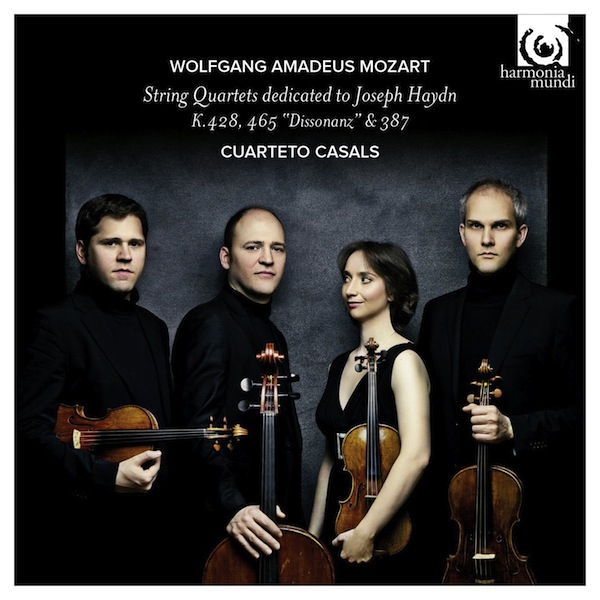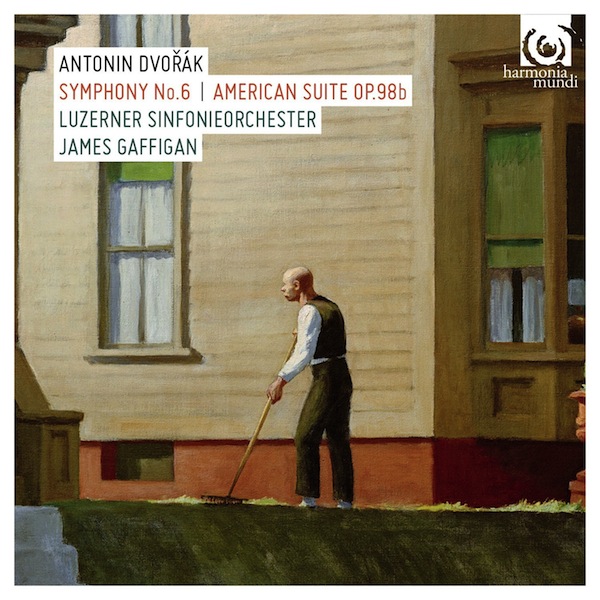Classical CD Reviews: Mozart’s “Haydn” Quartets and James Gaffigan conducts Dvorak (Harmonia mundi), plus James Brawn plays Beethoven (MSR Classics)
Cuarteto Casals brings out Mozart’s playfulness, the Luzerner Sinfonieorchester delivers a solid performance of Dvorak’s Sixth, and James Brawn continues to brilliantly play and insightfully interpret Beethoven’s piano sonatas.
By Jonathan Blumhofer
In some ways you’ve got to feel sorry for Mozart. Not only did he die young and impoverished, but, all too often, nobody really knows how to play his music. It’s beautiful stuff, to be sure, yet it’s not uncommon for conductors, soloists, and ensembles to emphasize the music’s elegance at the expense of its more life-giving attributes. I’ve often felt that, if only Mozart performers approached his works with the same energy and explosive attention to detail they regularly accord Haydn and Beethoven, there’d be much more to get excited about when it comes to Salzburg’s favorite son.
So I was quite pleased to come across the Cuarteto Casals’ new recording (also on Harmonia mundi) of three of Mozart’s “Haydn” string quartets (K. 387, 428, and 465), so named because of their dedication to Mozart’s musical elder. Appropriately, the Casals bring out all the music’s Haydn-esque quirks. Mozart rarely sounds as playful as he does here: the minuets, with their odd phrasings and abrupt shifts of mood, are marvelously characterful, and the big movements are positively symphonic.
A big reason for this is due to the ensemble’s close attention to the details of dynamics and articulation. You might think they were playing Beethoven, they way they exaggerate some of the contrasts between loud and soft, aggressive and restrained. And they’re not afraid to dig into their instruments. Sforzandi actually sound like sforzandi and, if there’s occasionally a kind of scrappy, in-your-face ensemble tone, so much the better: this is living, breathing music, not some musty old score played with too much reverence, and it’s refreshing to hear Mozart sounding downright lively.
As a result, the opening of the G major quartet (K. 387) is gripping, and the Casals’ account of the “Dissonance” Quartet (K. 465) stands shoulder-to-shoulder with the best already on record. In between, the E-flat major quartet finds a happy balance between taut energy and cool, elegant lyricism.
It all combines to make a disc that’s a whole lot of fun. The notes are all there – the Casals are as technically solid a group as you’ll ever hear – but, what’s more, they understand this music and they’re not afraid to take risks with it. A in their recent recording of Haydn’s Seven Last Words, they get at what’s beyond the notes on the page and the results, happily, linger.
*****
That Antonin Dvorak owed a significant stylistic debt to Johannes Brahms is nowhere clearer than in his Symphony no. 6. Parallels with Brahms, particularly with the latter’s Symphony no. 2 (with which Dvorak’s Sixth shares a key, D major) are both obvious and subtle: from the bucolic opening theme of the first movement and the extended pianissimo scoring at the start of the finale to the Symphony’s rich, chromatic harmonic language, Brahms’s influence is never far off.
Yet to suggest that Dvorak’s Sixth is, in effect Brahms’s Fifth, is to miss the mark pretty widely. The melodic writing is distinctly Dvorakian: sweeping, tuneful, and with not a few hints of folk inflections. The fantastic third movement furiant marks the only (labeled) appearance of that distinctive dance form in Dvorak’s symphonies and its spunky rhythmic drive is one that immediately calls to mind the Czech origins of its composer.
James Gaffigan’s new recording of the Sixth with the Luzerner Sinfonieorchester on Harmonia mundi accordingly emphasizes the piece’s Dvorakian characteristics. The rhythms bite and the melodic writing unfolds with inviting naturalness. Where it runs into some trouble is when it comes to the composer’s occasional tendency to verbosity: like Shostakovich, Dvorak sometimes wrote too much for his own good. And this performance never quite dispels the feeling that there’s more material in this symphony than need be.
Part of the reason for this has to do with tempos. Though they broadly observe the score’s metronome markings, Gaffigan and the Luzerners elect not to follow some of the music’s subtle but significant tempo shifts. The results (in the first movement, most notably) are rather stiff. The other part of the problem is more difficult to pin down and has to do with capturing the dramatic sweep of the music. From time to time, this performance locks in and runs brilliantly, but it’s not consistent: the sense of momentum ebbs and flows too much to really carry the whole reading forward, and that’s a pity, considering the generally fine playing of the ensemble. That said, this isn’t a bad recording – it’s just not one of the greats. For one of those, go with Kertesz and the London Symphony or Kubelik and the Berlin Philharmonic.
For filler, Gaffigan elicits some warm playing in the five-movement American Suite. My benchmark recording of this piece has long been Antal Dorati’s account with the Royal Philharmonic on Decca, which features a performance that’s highly characterful and musically generous. This one isn’t quite to Dorati’s level, but it does draw on the score’s substantial lyricism and finds several moments of sheer charm and beauty (the hopping rhythms of the third movement pollacca and a gorgeous account of the fourth movement among them).
*****
The third installment of James Brawn’s Beethoven piano sonata survey (MSR Classics) picks up right where the second left off: brilliantly played and insightfully interpreted.
Brawn’s precision of attack is most striking in the album’s opening work, the A major Sonata (op. 2, no. 2), which receives a reading as crisp and flowing as they come. The fast movements breathe the sort of easy charm that Beethoven appropriated from Haydn, while the slow one comes across as a beautiful essay in unaffected lyricism: touched with melancholy here and there, but only of a kind that passes quickly from shade to sun. All four movements are voiced with immaculate clarity.
Appropriately, it is nearly all shadows in the D minor “Tempest” Sonata, which is the middle piece on this disc. Brawn’s performance is characteristically individual. The outer movements are stormy, but in an understated way: you’re almost drawn into the drama of the music without realizing what’s happening.
Take the finale. Brawn begins it at an almost self-consciously deliberate pace, but the restrained tempo becomes the foundation for a fascinating study in rhythmic crosscurrents that grow more turbulent and unsettling as the movement progresses. It’s the musical equivalent of being drawn out to sea by a riptide and suddenly getting caught up in billowing waves that come out of nowhere. And so the whole performance feels, marrying as it does bewitching subtlety and awesome power.
Even more impressive is Brawn’s account of the Piano Sonata no. 26, “Les Adieux.” Here there’s a wonderful balance between the glittering, facile technical element – listen to Brawn easily navigate the cascading eighth notes in the first movement and the powerful left-hand playing in the finale – and a great depth of expression. Rarely does “Les Adieux’s” programmatic narrative come across with more electricity or intensity. In all, this is a reading that manages to be familiar yet genuinely exciting, inevitable but still spontaneous. Out of nearly a dozen fine recordings Brawn’s already made of the Beethoven sonatas, his “Les Adieux” rises to (or very near to) the top.
Producer Jeremy Hayes and recording engineer Ben Connellan deserve about as much credit as Brawn for their crystalline rendering of the music’s often-busy textures. Throughout the disc, Brawn draws out a wealth of tonal shadings – there are moments when the piano seems a cross between a fortepiano and a modern keyboard – that add richly to the expressive depth of these performances.
Jonathan Blumhofer is a composer and violist who has been active in the greater Boston area since 2004. His music has received numerous awards and been performed by various ensembles, including the American Composers Orchestra, Kiev Philharmonic, Camerata Chicago, Xanthos Ensemble, and Juventas New Music Group. Since receiving his doctorate from Boston University in 2010, Jon has taught at Clark University, Worcester Polytechnic Institute, and online for the University of Phoenix, in addition to writing music criticism for the Worcester Telegram & Gazette.
Tagged: Cuarteto Casals, Harmonia Mundi, James Brawn, James Gaffigan, Luzerner Sinfonieorchester



